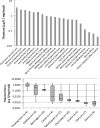Titanium dioxide nanoparticles in food and personal care products
- PMID: 22260395
- PMCID: PMC3288463
- DOI: 10.1021/es204168d
Titanium dioxide nanoparticles in food and personal care products
Abstract
Titanium dioxide is a common additive in many food, personal care, and other consumer products used by people, which after use can enter the sewage system and, subsequently, enter the environment as treated effluent discharged to surface waters or biosolids applied to agricultural land, incinerated wastes, or landfill solids. This study quantifies the amount of titanium in common food products, derives estimates of human exposure to dietary (nano-) TiO(2), and discusses the impact of the nanoscale fraction of TiO(2) entering the environment. The foods with the highest content of TiO(2) included candies, sweets, and chewing gums. Among personal care products, toothpastes and select sunscreens contained 1% to >10% titanium by weight. While some other crèmes contained titanium, despite being colored white, most shampoos, deodorants, and shaving creams contained the lowest levels of titanium (<0.01 μg/mg). For several high-consumption pharmaceuticals, the titanium content ranged from below the instrument detection limit (0.0001 μg Ti/mg) to a high of 0.014 μg Ti/mg. Electron microscopy and stability testing of food-grade TiO(2) (E171) suggests that approximately 36% of the particles are less than 100 nm in at least one dimension and that it readily disperses in water as fairly stable colloids. However, filtration of water solubilized consumer products and personal care products indicated that less than 5% of the titanium was able to pass through 0.45 or 0.7 μm pores. Two white paints contained 110 μg Ti/mg while three sealants (i.e., prime coat paint) contained less titanium (25 to 40 μg Ti/mg). This research showed that, while many white-colored products contained titanium, it was not a prerequisite. Although several of these product classes contained low amounts of titanium, their widespread use and disposal down the drain and eventually to wastewater treatment plants (WWTPs) deserves attention. A Monte Carlo human exposure analysis to TiO(2) through foods identified children as having the highest exposures because TiO(2) content of sweets is higher than other food products and that a typical exposure for a US adult may be on the order of 1 mg Ti per kilogram body weight per day. Thus, because of the millions of tons of titanium-based white pigment used annually, testing should focus on food-grade TiO(2) (E171) rather than that adopted in many environmental health and safety tests (i.e., P25), which is used in much lower amounts in products less likely to enter the environment (e.g., catalyst supports, photocatalytic coatings).
Figures




References
-
- [June 1st, 2011];ICIS Titanium Dioxide Uses and Market. http://www.icis.com/Articles/2007/11/07/9076546/titanium-dioxide-tio2-us....
-
- EPA U. External Review Draft - Nanomaterial Case Studies: Nanoscale Titanium Dioxide in Water Treatment and in Topical Sunscreen. National Center for Environmental Assessment, Office of Research and Development, U.S. Environmental Protection Agency; Research Triangle Park, NC: Jul, 2009. p. 222. EPA/600/R-09/057.
-
- Landsiedel R, Ma-Hock L, Kroll A, Hahn D, Schnekenburger J, Wiench K, Wohlleben W. Testing Metal-Oxide Nanomaterials for Human Safety. Advanced Materials. 2010;22(24):2601–2627. - PubMed
-
- Robichaud CO, Uyar AE, Darby MR, Zucker LG, Wiesner MR. Estimates of Upper Bounds and Trends in Nano-TiO2 Production As a Basis for Exposure Assessment. Environmental Science & Technology. 2009;43(12):4227–4233. - PubMed
-
- Hendren CO, Mesnard X, Droge J, Wiesner MR. Estimating Production Data for Five Engineered Nanomaterials As a Basis for Exposure Assessment. Environmental Science & Technology. 2011;45(7):2562–2569. - PubMed
Publication types
MeSH terms
Substances
Grants and funding
LinkOut - more resources
Full Text Sources
Other Literature Sources
Medical

